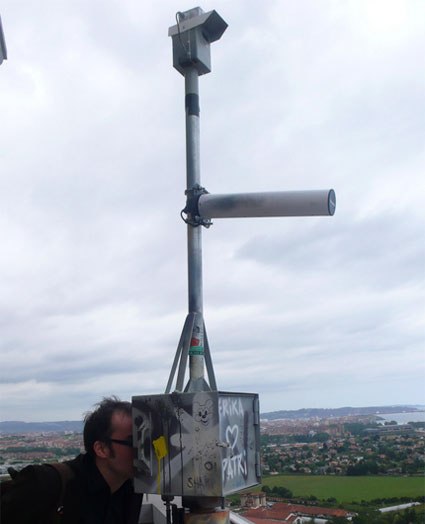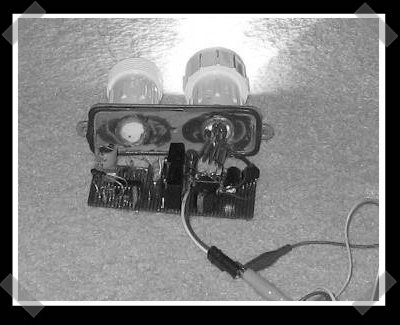
We Make Money Not Art recently visited the LABoral Art and Industrial Creation Centre in Gijón, Spain. The installation that left the strongest impression on [Regine] was the WiFi sightseeing telescope built by Clara Boj and Diego Diaz. Spain is in a situation similar to the USA: A few years ago many municipal WiFi projects launched only to be squashed because of theoretical unfair competition with local utilities. Now commercial projects like WeFi, Whisher, and FON encourage people to “share” their WiFi. Observatorio (Observatory) is designed to provide insight into the current state of local WiFi. It uses a highly directional Yagi antenna to collect wireless access data from the local area. The antenna has a 30deg aperture which is matched to a camera with an identical field of view. The observer sees the camera’s viewpoint with the WiFi data overlaid showing where accesspoints are and whether the AP is open. WMMNA also recommends you check out the WiFi Camera which photographs electromagnetic space.
Month: June 2008
BBtv: Playing The Building
Today’s episode of BoingBoing TV visits [David Byrne]’s Playing the Building installation which we covered before. The video provides some insight into the artistic process: they wandered around and whacked things with mallets to see what sounded good. They use counterweighted motors to vibrate cast iron girders and columns. Many of the empty radiators are being struck by solenoids. He says the installation is very approachable because people realize that even if a skilled musician sat down they wouldn’t be any better at playing the device.
New Vs. Old IPhone Apps

You’ve probably never heard of this obscure new device called the iPhone 3G from no-name manufacturer Apple, but we decided to give a rundown of some of its newest apps anyway. We’ll be comparing them to non-SDK third-party apps that only work on jailbroken iPhones.
DIY HID Ballast

HID lights have a major power consumption and lumen output advantage over halogen lights. Unfortunately the ballast component isn’t very cheap. [brian]’s been building his own ballasts for his mountain bike. We couldn’t find any more info on his design, but we did find some interesting stuff. This document lays out the requirements for a ballast. Here’s an older HID ballast design to get rolling. Keep in mind that the lamp requires high voltages – don’t play with it unless you know what you’re doing. If you’d rather use off the shelf components, check out the HID dive light we wrote up a while back. It uses a fairly inexpensive ballast/lamp combo.
Hackit: What To Do With A 1st Gen IPhone?

There’s a new iPhone 3G coming out in July. If that statement shocks you, you might want to check your connection. We love new shiny hardware, but what we’re really interested in is the number of “old” iPhones that are going to be hitting the market. Many people will be ditching their 1st generation iPhones just to get GPS and 3G. This abundance plus the new $200 price tag is bound to depress the price for used phones.
A used 1st generation iPhone is actually a pretty attractive device. It’s already been laid wide open by hackers so you can run pretty much anything you want on it instead of waiting for the App Store to tell you what you can and can’t do. You could use it as a WiFi Voip phone, a simple web pad, run an NES emulator, use it as a musical instrument, or build an army of robots.
What will you do when the price of used iPhones bottoms out?
Steven Laurie’s Art Of The Motor

We’ve served up dozens if not hundreds of machines with a practical purpose, but we are always interested in machines like those [Steven Laurie] makes, which serve no other purpose than looking impressive, spewing smoke, leaving tire marks, and making a lot of racket. We’ll give you the scoop on Steve’s motor art after the break.
RFID Reader Denial Of Service
While in Vancouver, Canada for CanSecWest we had a chance to catch up with [Marc]. He showed off a very simple Denial-of-Service attack that works for most commercial RFID reader systems. He worked out this physical DoS with [Adam Laurie], whose RFID work we featured last year.










